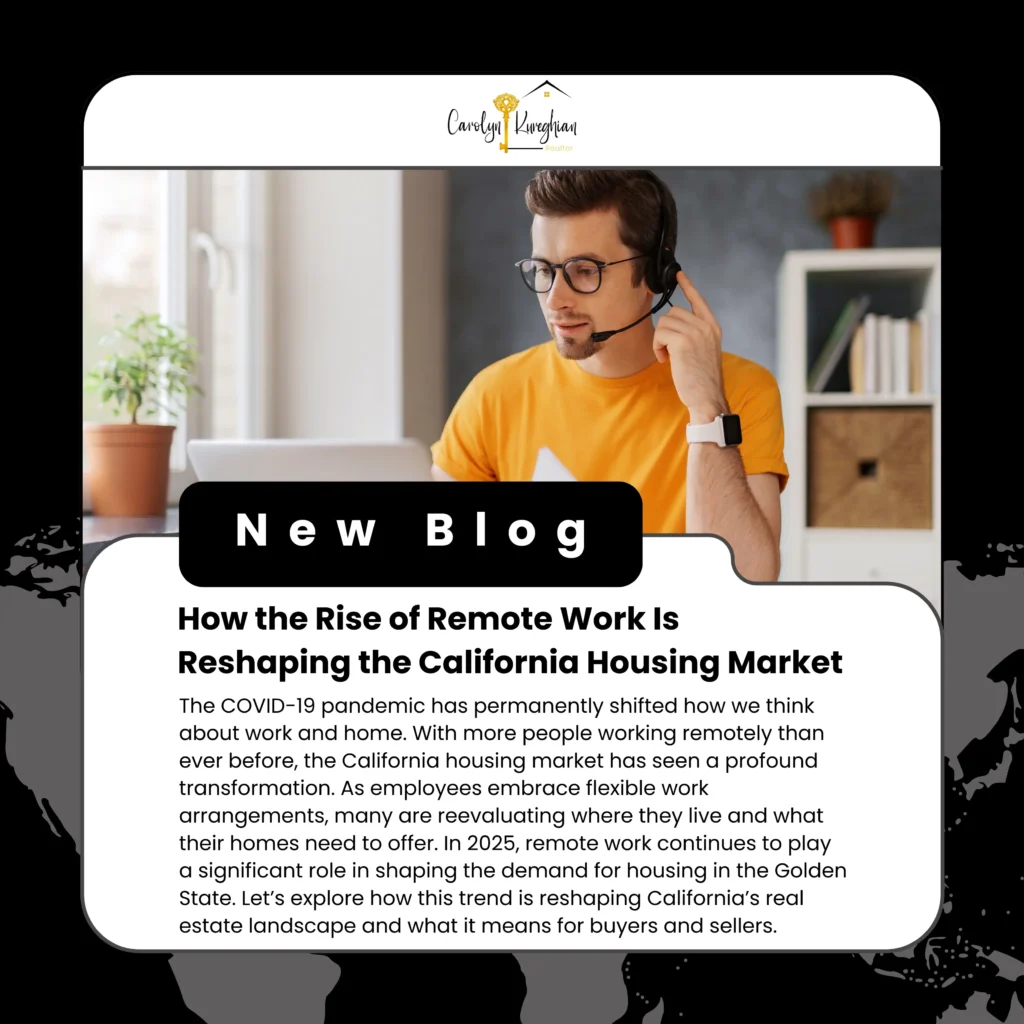Introduction:
The COVID-19 pandemic has permanently shifted how we think about work and home. With more people working remotely than ever before, the California housing market has seen a profound transformation. As employees embrace flexible work arrangements, many are reevaluating where they live and what their homes need to offer. In 2025, remote work continues to play a significant role in shaping the demand for housing in the Golden State. Let’s explore how this trend is reshaping California’s real estate landscape and what it means for buyers and sellers.
1. Suburban and Rural Areas Gaining Popularity
One of the most significant changes resulting from the rise of remote work is the migration from dense urban centers to suburban and rural areas. As Californians no longer need to commute to office buildings every day, many are seeking homes in quieter, more affordable areas with access to outdoor spaces and a slower pace of life.
- Popular Areas: Cities like Sacramento, Fresno, Santa Barbara, and parts of the Inland Empire are seeing a rise in demand. Smaller, more scenic areas like Napa Valley and the Central Coast are also becoming hotspots for those seeking a lifestyle change.
- Key Benefits: With remote work offering more flexibility, people can now live farther from their offices. These areas offer more space, larger homes, and lower prices compared to crowded metropolitan cities like San Francisco or Los Angeles.
2. The Growing Demand for Home Office Spaces
The need for dedicated home office spaces has become a top priority for many homebuyers in California. As remote work becomes a long-term fixture for many employees, homes with flexible spaces that can be transformed into functional offices are in high demand.
- What Buyers Are Looking For: Buyers are increasingly looking for properties that offer quiet, spacious rooms that can be converted into home offices. Properties with separate entrances or guest houses that can be repurposed for work are especially popular.
- Design Trends: The emphasis is on good lighting, soundproofing, and ample storage for work materials. In addition to a dedicated workspace, homebuyers are prioritizing high-speed internet connections, built-in shelving, and ergonomic features.
3. Desire for Larger Homes with More Outdoor Space
With more people spending time at home, the desire for larger properties with expansive outdoor areas is on the rise. Homebuyers are now looking for properties that offer not only additional square footage but also outdoor spaces where they can relax, entertain, and even work.
- Outdoor Features in Demand: Spacious backyards, home gardens, private patios, and outdoor offices have become highly desirable. Many buyers are also searching for homes with built-in outdoor kitchens, fire pits, and pools.
- Lifestyle Shifts: With remote work, Californians are placing a greater emphasis on enjoying time at home. The trend toward wellness has also made outdoor spaces a sanctuary for exercise, recreation, and relaxation.
4. Luxury Remote Workspaces: A New Trend
For high-income buyers, luxury remote workspaces are becoming a key factor when selecting a new home. Instead of simply converting a bedroom into an office, many wealthy buyers are investing in custom-built home offices that rival corporate offices in style, comfort, and functionality.
- Luxury Features: Home offices with panoramic views, state-of-the-art technology, and soundproofing are in demand. Some buyers are opting for entire floors dedicated to workspaces, complete with meeting rooms and virtual collaboration setups.
- Examples: Homes with dedicated office wings, private libraries, or separate studio spaces are increasingly sought after by professionals working remotely.
5. The Rise of Short-Term Rentals in Remote Locations
As remote work allows people to be location-independent, the popularity of short-term rentals is also on the rise. Many individuals and families are choosing to rent homes in remote locations for extended periods, taking advantage of flexible work arrangements to live in desirable vacation destinations.
- Trends in Rentals: Areas that were once considered vacation spots—such as Lake Tahoe, Big Bear, or Carmel-by-the-Sea—are seeing increased demand from remote workers looking to escape crowded cities while still being able to work.
- Impact on Real Estate: Investors are capitalizing on this trend by purchasing properties in these regions to convert into short-term rentals, catering to the demand for flexible living arrangements. This has led to a boom in vacation homes and properties ideal for extended stays.
6. Urban Shifts: From Office Space to Residential Conversion
While suburban and rural areas are seeing an uptick in demand, urban centers are also undergoing changes. In California’s largest cities, such as Los Angeles, San Francisco, and San Diego, office spaces that were once vacant due to remote work are being repurposed into residential properties.
- Repurposing Office Buildings: Developers are transforming former commercial spaces into apartments, lofts, and co-living spaces to meet the demand for affordable housing. This shift is helping to revitalize city neighborhoods that were hit hard by the pandemic’s impact on office leases.
- Mixed-Use Developments: Some areas are embracing mixed-use developments that combine residential, commercial, and entertainment spaces, catering to individuals who can work from home but still want to be close to the amenities and excitement of city life.
7. Increased Interest in Energy-Efficient and Health-Conscious Homes
With people spending more time at home, health and well-being have become major considerations when purchasing a property. Many homebuyers are now looking for homes that incorporate sustainable features, clean air systems, and wellness-focused amenities to improve their daily living environment.
- Eco-Friendly Features: Homes with energy-efficient appliances, solar panels, water-saving systems, and green building materials are becoming a top priority for remote workers. The added benefit is the reduction in utility costs over time.
- Health-Focused Design: Homes that feature air purification systems, home gyms, natural lighting, and access to outdoor spaces are also highly sought after by remote workers who prioritize well-being.
Conclusion:
Remote work is continuing to reshape the California housing market in 2025, and the ripple effect is being felt across the state. Suburban and rural areas are gaining popularity as people seek larger homes with dedicated workspaces and more outdoor amenities. Meanwhile, cities are adapting to the new reality by converting office spaces into residential properties. As this trend persists, both buyers and sellers will need to keep these shifts in mind to make the most of the changing landscape. Whether you’re looking to buy or sell a home in California, understanding how remote work is influencing the market is key to staying ahead of the curve.

